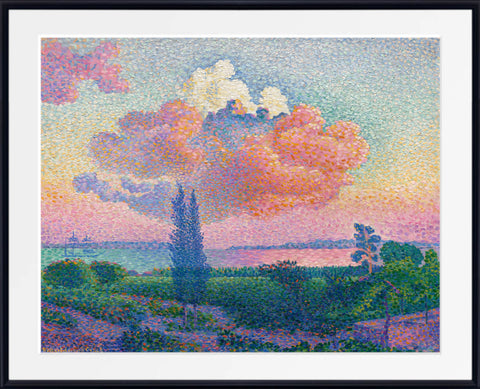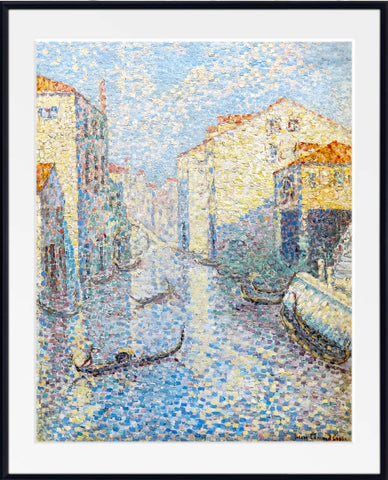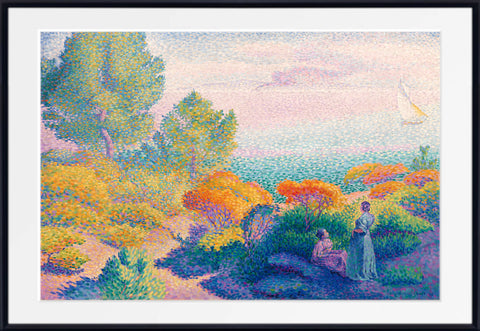Henri-Edmond Cross, born Henri-Edmond-Joseph Delacroix, was a luminary in the realm of French painting and printmaking. His indelible mark on the art world is primarily associated with Neo-Impressionism, where he played a pivotal role in shaping its second phase. In this blog post, we delve into the life, influences, and evolution of Henri-Edmond Cross's artistic journey.
Background and Education: Nurturing the Seeds of Artistry
Henri-Edmond-Joseph Delacroix, born in Douai in 1856, hailed from a family with a history of ironmongery. His early artistic inclinations were recognized and supported by his cousin, Dr. Auguste Soins. Under the guidance of painters like Carolus-Duran and François Bonvin, Cross's artistic journey began to take root.
Early Work: A Palette in Transition
Cross's early works reflected the somber colors of Realism, but he yearned to distinguish himself from the famed Romantic painter Eugène Delacroix. Thus, in 1881, he adopted the name "Henri Cross." Despite exhibiting at the Salon des Artistes Français in the same year, his departure from Realism was gradual. Influences from Jules Bastien-Lepage and Édouard Manet persisted until the late 1880s when his palette embraced the brighter colors of Impressionism.
Neo-Impressionism Unveiled: Cross's Evolution Continues
In 1891, a significant turning point occurred as Cross embraced Neo-Impressionism. His first large piece in this style, a divisionist portrait of Madame Hector France, marked a notable departure from his previous works. Cross's relocation to southern France in 1891, due to health reasons, further solidified his commitment to Neo-Impressionism.
Political Affinities: Art and Anarchism
Cross's affinity with the Neo-Impressionist movement extended beyond technique to political philosophies. Sharing anarchist principles with contemporaries like Signac and Pissarro, Cross painted scenes envisioning a utopian world under anarchism. This sentiment was encapsulated in his 1896 lithograph, "L'Errant" (The Wanderer), featured in the anarchist journal Les Temps Nouveaux.
Later Years: A Prolific Culmination
Cross's paintings of the mid-1890s showcased Pointillism, gradually transitioning to broad, blocky brushstrokes, foreshadowing Fauvism and Cubism. His late-career works, influential to artists like Matisse, Derain, and Marquet, formed the bedrock of Fauvism. Despite health issues, Cross remained productive, culminating in a successful solo exhibition in 1905.
Legacy and Exhibitions: Echoes Across Galleries
Henri-Edmond Cross's impact reverberates through numerous exhibitions, including those at Les XX, Libre Esthétique, and the first Neo-Impressionist exhibition in Germany. His paintings adorn prestigious collections worldwide, from the Metropolitan Museum of Art in New York to the Musée d'Orsay in Paris.
Henri-Edmond Cross FAQ's
-
Who was Henri-Edmond Cross?
- Henri-Edmond Cross, born Henri-Edmond-Joseph Delacroix, was a French painter and printmaker known for his mastery of Neo-Impressionism. He played a significant role in shaping the second phase of the movement and was a key influence on artists like Henri Matisse.
-
What is Neo-Impressionism?
- Neo-Impressionism is an art movement characterized by the use of tiny, distinct dots or strokes of color applied in patterns to form an image. This technique, also known as Pointillism or Divisionism, aimed to create vibrant and harmonious visual effects through the contrast of colors.
-
How did Cross's early works differ from his later ones?
- Cross's early works were in the dark colors of Realism. However, over time, he transitioned to brighter colors influenced by Impressionism. In 1891, he fully embraced Neo-Impressionism, adopting a divisionist style with small dots ofcolor.
-
What influenced Cross's change in artistic style?
- Cross's artistic evolution was influenced by various factors, including encounters with artists like Paul Signac and exposure to different painting styles such as Impressionism. His relocation to southern France in 1891 and health considerations also played a role in shaping his artistic choices.
-
Did Cross have political affiliations?
- Yes, Cross shared anarchist principles with fellow Neo-Impressionists like Signac and Pissarro. His artworks, particularly the 1896 lithograph "L'Errant," depicted scenes illustrating a utopian world envisioned through anarchism.
-
What is Fauvism, and how was Cross connected to it?
- Fauvism is an art movement characterized by bold color choices and a departure from realistic representation. Cross's late-career works, with their broad brushstrokes and vibrant colors, were instrumental in shaping the principles of Fauvism. Artists like Matisse and Derain were influenced by Cross.
-
How prolific was Cross in his later years despite health issues?
- Despite experiencing eye troubles and arthritis, Cross remained productive and creatively active in his last years. In 1905, he had a successful solo exhibition, and his works continued to receive critical acclaim.
-
Where can one find Cross's paintings today?
- Cross's paintings are featured in prominent museums and galleries worldwide, including the Musée d'Orsay in Paris, the Metropolitan Museum of Art in New York, and the Art Institute of Chicago.
-
What impact did Cross have on the art world after his death?
- Cross's legacy endured posthumously, with retrospectives and exhibitions celebrating his work. His influence extended to subsequent art movements, and his contributions are recognized in the broader context of art history.
-
When did Henri-Edmond Cross pass away, and how was his legacy honored?
- Henri-Edmond Cross passed away on May 16, 1910, at the age of 53. His tomb in the Le Lavandou cemetery features a bronze medallion designed by his friend Théo van Rysselberghe. In 1911, Douai, his birthplace, mounted a retrospective exhibition of his work to honor his artistic legacy.
Prints and Canvas Panels
Fine art prints and canvas panels of a curated selection of artworks by Henri-Edmond Cross are available in lots of sizes
Related Articles






